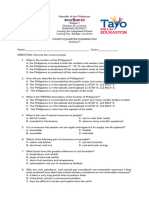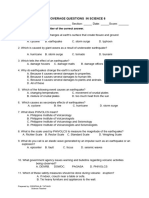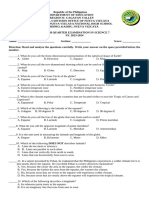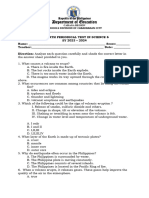Filipino
Filipino
Uploaded by
Maribel Satanes AltamarinoCopyright:
Available Formats
Filipino
Filipino
Uploaded by
Maribel Satanes AltamarinoOriginal Title
Copyright
Available Formats
Share this document
Did you find this document useful?
Is this content inappropriate?
Copyright:
Available Formats
Filipino
Filipino
Uploaded by
Maribel Satanes AltamarinoCopyright:
Available Formats
SCIENCE 7 FOURTH QUARTER SY 2022-2023
Name: ________________________________________ Score:_________________
Grade & Sec: ____________________________________ Date: __________________
Multiple Choice:
Directions: Choose the letter that best describes the following statements. Shade the letter of
your answer on the Answer sheet provided.
1. What do you call the horizontal lines found in the globe?
A. Equator B. Latitude C. Longitude D. Prime Meridian
2. What do you call the great circle that is halfway between the Northern and Southern
Hemisphere?
A. Equator B. Latitude C. Longitude D. Prime Meridian
3. Which of the following is the latitude of the equator?
A. 00 B. 900 N C. 900 S D. 900 E
4. Which of the following is considered as the greatest possible latitude found in the globe?
A. 900 N and 900 S C. 1800 N and 1800 S
0 0
B. 90 E and 90 W D. 1800 E and 1800 W
5. Which of the following is TRUE about the relationship between latitude and climate?
A. The nearer the place from the equator, the colder its climate.
B. The nearer the place from the equator, the warmer its climate.
C. The farther the place from the equator, the warmer its climate.
D. None of these is correct.
6. Which of the following statements is TRUE about lines of longitude?
A. Do not form circles C. Are not parallel to each other
B. Have the same length D. All of the above
7. If a country is between the Tropic of Cancer, Tropic of Capricorn and Equator it is most likely in
the _____.
A. Northern temperate zone C. Polar zone
B. Southern temperate zone D. tropical zone
Address: Signal Village, Barangay Sampaloc, Tanay, Rizal 1980
FB Page: Deped Tayo Blue Rizal Tanay Sampaloc Integrated National High School
Email Address: 301456@deped.gov.ph School ID: 301456
Fourth Periodical Test in SCIENCE 7
For numbers 8-10, locate the latitude of the points given in the globe below.
8. What is the latitude of point 2?
A. 00 B. 150 N C. 450 N D. 450 S
9. What is the longitude of point 9?
A. 300 E B. 300 W C. 450 N D. 450 S
10. W hat is the latitude and longitude of point 2?
A. 150 N, 450 E B. 150 N, 450 W C. 450 N, 150 E D. 450 N, 150 W
11. A sea cow (dugong) is at the Indian and West Pacific Oceans. In what direction is it moving if
it is heading to Coron in Palawan?
A. North B. East C. South D. West
12. How can you locate the exact places on the earth?
I. Use the lines of latitude only.
II. Use the lines of longitude only.
III. Use the parallel lines to describe the location.
IV. Use the intersecting lines of latitude and longitude
A. III only B. IV only C. I and III only D. II and III only
13. The latitude of an area greatly affects its climate. Which of the following describes the
relationship between latitude and climate?
I. The closer the latitude to the poles, the hotter the climate.
II. The closer the latitude to the poles, the colder the climate.
III. The closer the latitude to the equator, the colder the climate.
IV. The closer the latitude to the equator, the warmer the climate
A. I and III only B. I and IV only C. II and III only D. II and IV only
14. Our environment has many bodies of water and landforms. The things that we take and use
from the environment to survive are called _______.
A. raw materials C. natural resources
B. chemical energy D. rocks and minerals
15. Resources that can be replaced after using them again and again are called _______.
A. nonrenewable B. recyclable C. renewable D. reusable
16. What do you call the resources that require long years before they can be replenished?
Address: Signal Village, Barangay Sampaloc, Tanay, Rizal 1980
FB Page: Deped Tayo Blue Rizal Tanay Sampaloc Integrated National High School
Email Address: 301456@deped.gov.ph School ID: 301456
Fourth Periodical Test in SCIENCE 7
A. Nonrenewable B. Recyclable C. Renewable D. Reusable
17. Which of the following is correctly matched?
A. Coal: Renewable C. Aluminum: Renewable
B. Cotton: Nonrenewable D. Minerals: Nonrenewable
18. Which of the following DOES NOT show conservation of natural resources?
A. Mr. Agustin uses too much chemical fertilizers in his farm.
B. Elna turns off her car’s engine when idling longer than 15 minutes.
C. Chiara opens the windows instead of turning on the air conditioner.
D. Mrs. Perez fills a bucket while showering and use it to water her plants.
19. Philippines is home of different species of plants and animals. Do you agree that our latitude
position in the globe can influence the high diversity of life forms?
A. No, the diversity of life forms in the country does not depend on its position in the globe.
B. No, the latitude position of our country does not affect the high diversity of life forms at all.
C. Yes, the Philippines is one lucky country with thick forests, bodies of water, fertile soil, and
many landforms.
D. Yes, the Philippines receives year-round sunshine and abundant rainfall that are needed by
plants and animals to grow and reproduce.
20. In which layer of the atmosphere where nearly all weather phenomena occur?
A. Mesosphere B. Stratosphere C. Thermosphere D. Troposphere
21. Which layer protects us from harmful ultraviolet rays?
A. Mesosphere B. Stratosphere C. Troposphere D. Ozone layer
22. What are the most abundant gases in Earth’s atmosphere?
A. Nitrogen and Oxygen C. Carbon Dioxide and Oxygen
B. Nitrogen and Hydrogen D. Carbon Dioxide and Nitrogen
23. In which layer of the atmosphere do planes fly to get out from the weather disturbances?
A. Exosphere B. Mesosphere C. Stratosphere D. Thermosphere
24. What happens to the temperature as you go higher in the troposphere?
A. It increases. C. It stays the same
B. It decreases. . D. It increases then decreases.
25. What is the correct order of Earth's atmospheric layers from layer closest to the earth’s surface
to outermost layer?
A. Stratosphere, Mesosphere, Troposphere, Thermosphere, Exosphere
B. Troposphere, Mesosphere, Stratosphere, Thermosphere, Exosphere
C. Troposphere, Stratosphere, Mesosphere, Thermosphere, Exosphere
D. Exosphere, Stratosphere, Troposphere, Thermosphere, Mesosphere
26. What will happen if there is too much carbon dioxide in the atmosphere?
A. climate change C. Greenhouse effect occurs
B. temperature increases D. water vapor condenses
27. Which of the following is NOT a greenhouse gas?
A. Methane C. Nitrous Oxide
Address: Signal Village, Barangay Sampaloc, Tanay, Rizal 1980
FB Page: Deped Tayo Blue Rizal Tanay Sampaloc Integrated National High School
Email Address: 301456@deped.gov.ph School ID: 301456
Fourth Periodical Test in SCIENCE 7
B. Chlorine D. Carbon Dioxide
28. Why is Ozone important to life on Earth?
A. It provides all the oxygen to Earth.
B. It reflects all the ultraviolet radiation of the sun.
C. It absorbs all the heat that come up from the Earth.
D. It protects the Earth’s atmosphere and the life on Earth from harmful radiant energy emitted by
the sun.
29. What happened to the level of carbon dioxide in the atmosphere over the past 200 years?
A. Decreased slightly C. Stayed about the same
B. Increased steadily D. Increased until recently and then decreased
30. How does the increased in carbon dioxide cause global warming?
A. It reflects more sunlight from clouds.
B. It traps more heat in the atmosphere
C. It reduces the amount of oxygen in the air.
D. It allows more sunlight into the atmosphere.
For items 31 and 32, refer to the figure below.
31. Which of the following statements are true about the figure shown above?
I. Sun is the Earth’s major source of energy.
II. Greenhouse gases include CO2, CH4, ozone and water vapour.
III. Not all the sun’s heat is absorbed by the Earth; some is reflected back in space.
IV. Greenhouse gases absorbs infrared radiation from the earth and re-radiate it back to the Earth.
A. I and III only C. II and IV only
B. I and IV only D. I, II, III and IV
32. What are the important roles of the greenhouse gases?
I. It is necessary for communication.
II. It reflects back the sun’s rays to Earth to keep it cold.
III. It helps the Sun in providing the energy needed by Earth.
IV. It absorbs infrared radiation from the earth and re-radiate it back to the Earth.
A. IV only B. II and IV only C. II and III only D. I, II and III only
Address: Signal Village, Barangay Sampaloc, Tanay, Rizal 1980
FB Page: Deped Tayo Blue Rizal Tanay Sampaloc Integrated National High School
Email Address: 301456@deped.gov.ph School ID: 301456
Fourth Periodical Test in SCIENCE 7
33. What causes air to rise in the atmosphere?
A. Increases of air pressure
B. Increases in temperature of air
C. Decreases in temperature of air
D. Decrease of both pressure and temperature of air
34. Which of the following will occurs in the atmosphere due to temperature differences of air?
A. Melting of cool air C. Floating of warm and cool air
B. Sinking of warm air D. Sinking of cool air and rising of warm air
35. How does air move in land breeze?
A. From sea to land C. From east to west
B. From land to sea D. From west to east
36. When warm air rises on land or water, what happens to the air pressure at the surface?
A. Constant B. High C. Low D. Unstable
37. Why do you think your father loves to swim at night time rather than during daytime?
A. The sea water is cold at night time.
B. The sea water is hot at night time.
C. The sea water is hot during daytime.
D. The sea water is cold during daytime.
38. Your teacher explained that the wind direction during the day is usually the reverse of wind
direction at night. Do you agree with your teacher?
A. No, because breezes describe movement of air in one direction.
B. No, because this is only an indication of change in our weather condition.
C. Yes, because of the differences in air pressure and temperature between two different places.
D. Yes, because the air temperature remains the same all throughout the day between two
different places.
39. What are the four seasons of Earth?
A. Rainy, Summer, Dry and Wet C. Spring, Summer, Fall, Winter
B. Autumn, Spring, Fall, Winter D. Summer, Fall, Dry and wet, Winter
40. What causes the season?
A. The earth’s revolution C. The earth’s axis
B. The earth’s tilt D. The earth’s rotation
41. .It is the reason that causes the length of daylight to change.
A. It depends on the shape of the planet.
B. It is based on how far the sun rays reach.
C. It is based on the tilt of the sun beside the planet.
D. It depends on the tilt of the earth as it moves around the sun.
42. Which part of the Earth receives the greatest amount of heat from the sun?
A. Equator C. Northern Hemisphere
B. North Pole D. Southern Hemisphere
43. Why does air temperature increase in the summertime?
A. We are closer to the sun.
B. The air becomes thicker and denser.
Address: Signal Village, Barangay Sampaloc, Tanay, Rizal 1980
FB Page: Deped Tayo Blue Rizal Tanay Sampaloc Integrated National High School
Email Address: 301456@deped.gov.ph School ID: 301456
Fourth Periodical Test in SCIENCE 7
C. The sun's rays are more direct and days are longer.
D. The ratio of the hours of daylight to the hours of night is reduced.
44. When the North Pole is tilted toward the Sun, will the daytime be longer than night time in the
Northern Hemisphere?
A. Yes, because it receives direct rays.
B. Yes, because it receives diagonal rays.
C. No, because it receives heat around the sun.
D. No, because it receives oblique rays from the sun.
45. . Which of the following astronomical phenomena shows shadow formation?
A. Eclipses C. Collision of asteroids
B. Birth of a star D. Rotation of Earth on its axis
46. What type of eclipse occurs when the Moon travels completely into the Earth’s umbra?
A. Total lunar eclipse C. Total solar eclipse
B. Partial lunar eclipse D. Partial solar eclipse
47. What type of eclipse occurs if the Earth’s umbra is cast on the Moon?
A. Total lunar eclipse C. Total solar eclipse
B. Partial lunar eclipse D. Partial solar eclipse
48. Which of the following is the correct alignment of lunar eclipses?
A. Sun – Moon – Earth
B. Earth – Sun - Moon
C. Earth – Moon – Sun
D. Sun – Earth – Moon
49. Which of the following statement is true about eclipse?
A. Watching a lunar eclipse during your pregnancy, your baby will have a cleft lip.
B. People lock themselves indoors avoid the bad rays of the eclipsed sun.
C. It is believed that during the eclipse the sun is swallowed by demons, dragons or devilish dogs.
D. Sun's rays can impair or cause permanent eye damage when viewed through the naked eye.
50. Chris performs an experiment about solar eclipse. He cut different sizes of circles where the
sun is biggest followed by the earth and the moon. He aligned the three circles, with the earth in
between the sun and the moon. Is his set-up CORRECT?
A. Yes, because there is the sun.
B. No, because the moon must be absent during solar eclipse.
C. No, because the moon should be is at the center.
D. Yes, because the three astronomical objects have different diameter and the alignment of the
three where the earth is at the center causes solar eclipse
Prepared by:
Address: Signal Village, Barangay Sampaloc, Tanay, Rizal 1980
FB Page: Deped Tayo Blue Rizal Tanay Sampaloc Integrated National High School
Email Address: 301456@deped.gov.ph School ID: 301456
Fourth Periodical Test in SCIENCE 7
CHRISTOPHER GEORGE R. PAZA
Teacher III, ANHS
Checked and Validated by:
LIRIO GRACIA ST BACARESAS
TEACHER II, TANAY NHS
Noted:
MORENA SM. RAYMUNDO
Science Consultant
Address: Signal Village, Barangay Sampaloc, Tanay, Rizal 1980
FB Page: Deped Tayo Blue Rizal Tanay Sampaloc Integrated National High School
Email Address: 301456@deped.gov.ph School ID: 301456
Fourth Periodical Test in SCIENCE 7
Address: Signal Village, Barangay Sampaloc, Tanay, Rizal 1980
FB Page: Deped Tayo Blue Rizal Tanay Sampaloc Integrated National High School
Email Address: 301456@deped.gov.ph School ID: 301456
You might also like
- Grade 7 4th Quarter ExamDocument6 pagesGrade 7 4th Quarter ExamSher Sherwin93% (15)
- Science 6, 4th Quarter TestDocument5 pagesScience 6, 4th Quarter TestSonny Matias94% (17)
- Science 4th PTDocument6 pagesScience 4th PTMARICSON TEOPENo ratings yet
- Diagnostic Examination Grade 8Document18 pagesDiagnostic Examination Grade 8RUTH MIASCONo ratings yet
- Science 7 4th Peridic TestDocument5 pagesScience 7 4th Peridic TestBettina SanchezNo ratings yet
- 4TH QuarterDocument6 pages4TH QuarterTEACHER MILLAN TVNo ratings yet
- Q4 - Science 7 PTDocument6 pagesQ4 - Science 7 PTJoana VerderaNo ratings yet
- TQ - Q4 - SCIENCE - 7 - Aster Madalla - Asterio MadallaDocument11 pagesTQ - Q4 - SCIENCE - 7 - Aster Madalla - Asterio MadallaKhim YabesNo ratings yet
- Science 7Document7 pagesScience 7yuwhanshikamuraNo ratings yet
- Pre Test - Q4Document4 pagesPre Test - Q4Jon-Jon ManlapasNo ratings yet
- Pretest-Q4Document4 pagesPretest-Q4cuestayroxieNo ratings yet
- 4Q Science G7Document5 pages4Q Science G7Kimmy Grace TañoNo ratings yet
- S7 Q4 Summative-Test-2Document7 pagesS7 Q4 Summative-Test-2joan marie PeliasNo ratings yet
- 4TH Quarter ExaminationDocument6 pages4TH Quarter ExaminationEddiely OlvidoNo ratings yet
- 4TH Exam - Sci 7Document4 pages4TH Exam - Sci 7Julius Magaru Raquel100% (1)
- Q4 Summative Test Science 7Document4 pagesQ4 Summative Test Science 7Anna Liza GomezNo ratings yet
- Summative Test 4th 4Document3 pagesSummative Test 4th 4Jerome CasillaNo ratings yet
- Summative Test in Science 7Document3 pagesSummative Test in Science 7MICAH NORADANo ratings yet
- Grade 7 Q4Document3 pagesGrade 7 Q4JosephineNo ratings yet
- 4th Quarter PretestDocument4 pages4th Quarter PretestHezel MarieNo ratings yet
- Sci 7 Long Test and 4TH Periodical Test 4TH With TosDocument6 pagesSci 7 Long Test and 4TH Periodical Test 4TH With TosRochelle VilelaNo ratings yet
- 11111Document4 pages11111Jezha Mae VertudazoNo ratings yet
- SCIENCEDocument4 pagesSCIENCEMERRY GRACE CABRERANo ratings yet
- Science 7 4th QuarterDocument9 pagesScience 7 4th Quarterangelicaabing3No ratings yet
- Science 7 Q4 TestDocument7 pagesScience 7 Q4 TestCarmina DuldulaoNo ratings yet
- SCIENCE 7 Summative Test Q4Document2 pagesSCIENCE 7 Summative Test Q4Joralyn Compuesto-Francisco TañanNo ratings yet
- Science 7Document6 pagesScience 7gladys.tuvieronNo ratings yet
- Summative Test For Fourth QuarterDocument6 pagesSummative Test For Fourth Quarterkian abpiNo ratings yet
- Your Answers in The Answer Sheet.: Curriculum Implementation DivisionDocument6 pagesYour Answers in The Answer Sheet.: Curriculum Implementation DivisionNoralyn GunnawaNo ratings yet
- First Written Test in Science 7 QUARTER 4, SY 2021-2022 Instructions: Read Each Question Carefully and Write The Correct Answer in ADocument6 pagesFirst Written Test in Science 7 QUARTER 4, SY 2021-2022 Instructions: Read Each Question Carefully and Write The Correct Answer in Ajoan marie PeliasNo ratings yet
- SUMMATIVE TEST 4th QuarterDocument2 pagesSUMMATIVE TEST 4th QuarterLea SantillanNo ratings yet
- 4Q Sci 7 PTDocument4 pages4Q Sci 7 PTmay flor obonNo ratings yet
- 4th Quarter Sci 7Document2 pages4th Quarter Sci 7Zir AdaNo ratings yet
- Grade 7 Regular SCience - 4th QuarterDocument5 pagesGrade 7 Regular SCience - 4th QuarterLalaine MamaedNo ratings yet
- Fourth Quarter Examination 7Document8 pagesFourth Quarter Examination 7Jennilyn AgootNo ratings yet
- Diagnostic Test in Science Grade 8 School Year 2018-2019: Schools Division Office Quezon CityDocument5 pagesDiagnostic Test in Science Grade 8 School Year 2018-2019: Schools Division Office Quezon CitydoidoiNo ratings yet
- 4th Quarter Science 7Document5 pages4th Quarter Science 7diannemaereyes98No ratings yet
- 4th QUARTEST TEST SCIENCE 7Document6 pages4th QUARTEST TEST SCIENCE 7Geraldine Dioquino RosalesNo ratings yet
- Science7 Q4 Mod1 LocatingPlacesoftheEarth V1Document34 pagesScience7 Q4 Mod1 LocatingPlacesoftheEarth V1RUTH MIASCO0% (1)
- 4th Periodical Test-Test Questions (Grade 6)Document8 pages4th Periodical Test-Test Questions (Grade 6)Annaliza Galia Junio81% (26)
- Grade 7 Science QuestionnaireDocument5 pagesGrade 7 Science QuestionnaireYasmin Abigail Aserios0% (1)
- Science 7 Summative Test 4thmod.2Document3 pagesScience 7 Summative Test 4thmod.2Marian Anion-Gaurano100% (1)
- Grade 7 ScienceDocument3 pagesGrade 7 ScienceMarston Glenn F. Tugahan100% (1)
- Crispina-Q4 - Pt-Science 6Document6 pagesCrispina-Q4 - Pt-Science 6crispina.tatang001No ratings yet
- 4Q Science 7 PTDocument4 pages4Q Science 7 PTGeorge Claro BayerNo ratings yet
- F3 Soc Stud Exam 2013Document25 pagesF3 Soc Stud Exam 2013Andrew ArahaNo ratings yet
- 4th Grading FINAL EXAM For PrintintDocument5 pages4th Grading FINAL EXAM For Printintveronica dumanopNo ratings yet
- ES - Q1 - Summative Test 1Document9 pagesES - Q1 - Summative Test 1Shekaina Faith Cuizon Lozada100% (1)
- SCIENCE-6-4th-Quarter FINALDocument11 pagesSCIENCE-6-4th-Quarter FINALEdwin Tejano BetangcorNo ratings yet
- 10go Up Science SummativeDocument9 pages10go Up Science SummativeMark Anthony Telan PitogoNo ratings yet
- SCIENCE 7 4th QuarterDocument8 pagesSCIENCE 7 4th QuarterJezha Mae NelmidaNo ratings yet
- Science 7-LONG QUIZ 4Document4 pagesScience 7-LONG QUIZ 4Filii ZamorensisNo ratings yet
- 4th Periodic Test Science 6 2018 2019Document7 pages4th Periodic Test Science 6 2018 2019Kristine BarredoNo ratings yet
- Sci 7 4TH Periodical Test 4TH With TosDocument6 pagesSci 7 4TH Periodical Test 4TH With Tosmarkmia4334fajardoNo ratings yet
- Science 7 Final Summative TeastDocument2 pagesScience 7 Final Summative TeastEnrick PestilosNo ratings yet
- Final Exam Physical Science 1Document4 pagesFinal Exam Physical Science 1Coreen tabioloNo ratings yet
- 1st Validating Assessment - Earth and Life ScienceDocument3 pages1st Validating Assessment - Earth and Life ScienceMALOU ELEVERANo ratings yet
- Things You Can Do: How to Fight Climate Change and Reduce WasteFrom EverandThings You Can Do: How to Fight Climate Change and Reduce WasteNo ratings yet
- This Book Will (Help) Cool the Climate: 50 Ways to Cut Pollution and Protect Our Planet!From EverandThis Book Will (Help) Cool the Climate: 50 Ways to Cut Pollution and Protect Our Planet!No ratings yet
- Ashrae Singapore Weather DataDocument2 pagesAshrae Singapore Weather DataErwin ManalangNo ratings yet
- Climate ChangeDocument1 pageClimate ChangeRahulKumarSinghNo ratings yet
- Climatic Data ElementsDocument9 pagesClimatic Data ElementsNico RobinNo ratings yet
- BrochureDocument2 pagesBrochureArchit ChauhanNo ratings yet
- Hurricanes (Notes)Document3 pagesHurricanes (Notes)Elijah FelipeNo ratings yet
- Activity Sheet in Science 6Document3 pagesActivity Sheet in Science 6Josie Bacnihan BayachanNo ratings yet
- A2 Weather Hazards and Climate Revision My VersionDocument99 pagesA2 Weather Hazards and Climate Revision My VersionluciaNo ratings yet
- Animal Climatology: Elements of ClimateDocument53 pagesAnimal Climatology: Elements of ClimateJane LabradorNo ratings yet
- Hydrometeorology - ActivityDocument5 pagesHydrometeorology - ActivityAsmaira KaminNo ratings yet
- Typhoons in The PhilippinesDocument32 pagesTyphoons in The PhilippinesCherilyn Saagundo100% (1)
- SHM 005 Clip Visibility1Document14 pagesSHM 005 Clip Visibility1Dipanjan ChoudhuryNo ratings yet
- QUIZ 4 ReviewerDocument2 pagesQUIZ 4 ReviewerNervey Nhea OblanNo ratings yet
- HTT 280 Chapter 1 - Introduction To Geography and CultureDocument29 pagesHTT 280 Chapter 1 - Introduction To Geography and CulturefasehaaqileenNo ratings yet
- G7 4Q SW WeatherDist LearningCent WorksheetDocument1 pageG7 4Q SW WeatherDist LearningCent WorksheetUmakishueNo ratings yet
- Tropical DesignDocument42 pagesTropical DesignElaine BalquinNo ratings yet
- Week5 Q3 Science9Document5 pagesWeek5 Q3 Science9REYMART TANSIONGCONo ratings yet
- BWI-Kalipuro - (STA2) 2016Document4 pagesBWI-Kalipuro - (STA2) 2016Edi AriyantoNo ratings yet
- Science - Weather Unit PlanDocument26 pagesScience - Weather Unit Planapi-336712848No ratings yet
- Metklim FullDocument73 pagesMetklim FullFrizka DecyoorinNo ratings yet
- Climate Trends and Projections in The Philippines by Rosalina G. de Guzman Assistant Weather Services Chief PAGASA-DOSTDocument43 pagesClimate Trends and Projections in The Philippines by Rosalina G. de Guzman Assistant Weather Services Chief PAGASA-DOSTJay Castillo100% (1)
- Types of Clouds. Cirrocumulus Cirrostratus CirrusDocument48 pagesTypes of Clouds. Cirrocumulus Cirrostratus CirrusMircea PetcuNo ratings yet
- The Amazon ForestDocument1 pageThe Amazon Forestjames5028No ratings yet
- RajoxDocument2 pagesRajoxEfraim AlmeidaNo ratings yet
- Outline Physical Geography For CssDocument35 pagesOutline Physical Geography For CssUsman Shahid JuttNo ratings yet
- When Tornadoes StrikeDocument2 pagesWhen Tornadoes StrikeThư DươngNo ratings yet
- Corona A. Cabanilla National High School: Direction: Choose The Letter of The Correct AnswerDocument6 pagesCorona A. Cabanilla National High School: Direction: Choose The Letter of The Correct Answerrain sagotNo ratings yet
- BSC Agri Syllabus NewDocument306 pagesBSC Agri Syllabus Newvaibhav1004No ratings yet
- How To Read Weather Map PDFDocument1 pageHow To Read Weather Map PDFnaitx50% (2)
- Atm, Comp, Structure PDFDocument36 pagesAtm, Comp, Structure PDFkshitijnagrale07No ratings yet
- AIRCONDITIONING and Ventilation SystemDocument12 pagesAIRCONDITIONING and Ventilation SystemStephanie ParkNo ratings yet

























































































